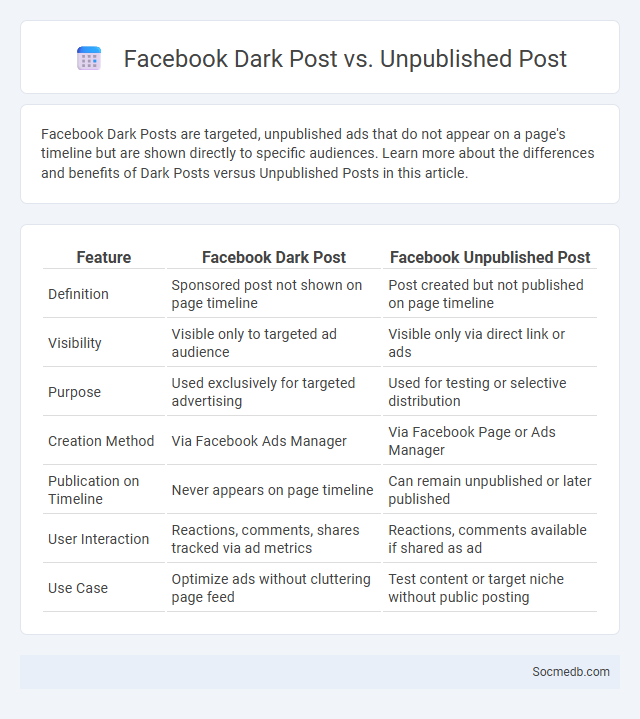
Photo illustration: Facebook Dark Post vs Unpublished Post
Facebook Dark Posts are targeted, unpublished ads that do not appear on a page's timeline but are shown directly to specific audiences. Learn more about the differences and benefits of Dark Posts versus Unpublished Posts in this article.
Table of Comparison
| Feature | Facebook Dark Post | Facebook Unpublished Post |
|---|---|---|
| Definition | Sponsored post not shown on page timeline | Post created but not published on page timeline |
| Visibility | Visible only to targeted ad audience | Visible only via direct link or ads |
| Purpose | Used exclusively for targeted advertising | Used for testing or selective distribution |
| Creation Method | Via Facebook Ads Manager | Via Facebook Page or Ads Manager |
| Publication on Timeline | Never appears on page timeline | Can remain unpublished or later published |
| User Interaction | Reactions, comments, shares tracked via ad metrics | Reactions, comments available if shared as ad |
| Use Case | Optimize ads without cluttering page feed | Test content or target niche without public posting |
Understanding Facebook Dark Posts
Facebook Dark Posts are unpublished ads that appear only to targeted audiences, enabling precise marketing campaigns without cluttering public pages. These posts allow advertisers to test different content, demographics, and messaging to optimize engagement and conversions. Utilizing Facebook's advanced targeting tools, businesses can reach specific user segments with tailored ads that do not affect their organic page feed.
What Are Unpublished Posts on Facebook?
Unpublished posts on Facebook, also known as dark posts, are ads or content created but not publicly visible on your timeline or page feed. These posts allow you to target specific audiences with customized messages without cluttering your public content, enhancing targeted advertising strategies. You can manage unpublished posts through Facebook Ads Manager to optimize your social media marketing campaigns effectively.
Facebook Dark Post vs Unpublished Post: Key Differences
Facebook Dark Posts and Unpublished Posts both allow advertisers to create targeted content not visible on their public page. Dark Posts are specifically boosted ads appearing only in selected users' feeds without a public timeline presence, optimizing audience segmentation. Unpublished Posts, often synonymous with Dark Posts, refer to content created for paid campaigns without organic distribution, ensuring precise control over ad exposure and performance metrics.
How Dark Posts Work in Facebook Advertising
Dark posts on Facebook are unpublished ads that don't appear on your page's timeline but are targeted directly to specific audiences, optimizing reach and engagement without cluttering your public feed. These ads allow you to test different creative elements, messages, and audience segments, gathering precise data to refine your marketing strategy. Understanding how dark posts work enables your campaigns to achieve higher conversion rates by delivering personalized content effectively to your desired customer base.
Unpublished Posts: Features and Benefits
Unpublished posts on social media platforms allow businesses to create and target ads without displaying them on their public timeline, enhancing audience segmentation and campaign effectiveness. These posts enable marketers to test content performance and optimize engagement through precise demographic targeting based on user behavior and interests. Utilizing unpublished posts reduces content clutter on official pages while maximizing reach and conversion rates through tailored advertising strategies.
Why Marketers Use Facebook Dark Posts
Marketers use Facebook Dark Posts to target specific audiences with highly personalized content without cluttering their main brand page. These unpublished posts enable precise A/B testing and performance tracking, optimizing ad spend for better engagement and conversion rates. Dark Posts also allow brands to maintain a tailored message across diverse demographic segments while preserving their public-facing social media identity.
Targeting Audiences with Facebook Dark Posts
Facebook Dark Posts enable precise audience targeting by creating unpublished, customized ads visible only to selected groups, improving engagement rates and conversion efficiency. These ads leverage Facebook's advanced demographic, interest, and behavior filters to reach niche markets without cluttering a brand's main page. Utilizing Dark Posts allows marketers to test different messages and creatives, refining campaigns based on real-time performance data.
Unpublished Posts for A/B Testing and Experimentation
Unpublished posts on social media platforms enable your marketing team to conduct A/B testing and experimentation without exposing content to your public audience prematurely. By leveraging unpublished posts, you can analyze engagement metrics, optimize messaging, and refine creative elements to enhance campaign performance. This strategy ensures data-driven decisions that boost overall social media effectiveness and ROI.
Common Misconceptions: Dark Post vs Unpublished Post
A dark post on social media is an ad that appears in users' feeds but isn't visible on your profile, designed specifically for targeted campaigns, whereas an unpublished post is similar in nature but remains completely hidden from your timeline, often used for testing audience reactions without public exposure. Both formats enable precise audience segmentation and campaign optimization without cluttering your main feed, but understanding the distinction ensures you deploy the right strategy for your advertising objectives. Clarifying these differences helps improve your campaign reach and engagement by using each post type effectively.
Best Practices for Using Facebook Dark and Unpublished Posts
Facebook dark and unpublished posts allow targeted advertising without cluttering your main feed, enhancing audience segmentation through tailored content. These posts enable precise A/B testing and optimization by monitoring engagement metrics such as click-through rates and conversions without public visibility. Employing clear objectives, compelling visuals, and strategic call-to-actions maximizes campaign effectiveness and return on ad spend.
 socmedb.com
socmedb.com